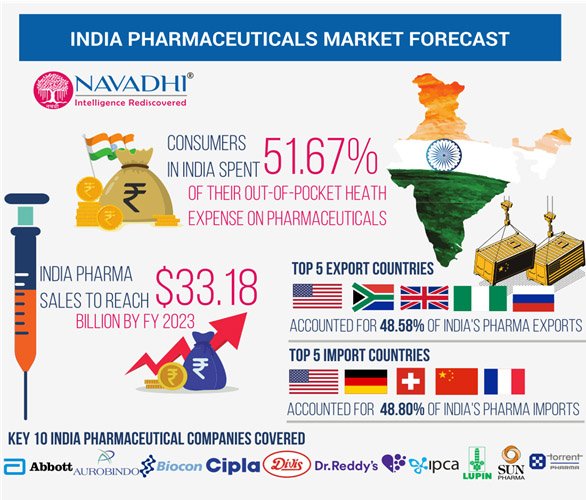INDIA’S PHARMA INDUSTRY

STATUS OF INDIA’S PHARMA INDUSTRY:
- India is the largest provider of generic drugs globally and is known for its affordable vaccines and generic medications.
- The Indian Pharmaceutical industry is currently ranked third in pharmaceutical production by volume.
- Generic drugs, over-the-counter medications, bulk drugs, vaccines, contract research & manufacturing, biosimilars, and biologics are some of the major segments of the Indian pharma industry.
- India has the most number of pharmaceutical manufacturing facilities that are in compliance with the US Food and Drug Administration (USFDA) and has 500 API producers that make for around 8% of the worldwide API market.
- Indian pharmaceutical sector supplies over 50% of global demand for various vaccines, 40% of generic demand in the US and 25% of all medicine in the UK.

SOURCE: NAVADHI MARKET RESEARCH
- The domestic pharmaceutical industry includes a network of 3,000 drug companies and ~10,500 manufacturing units.
- India enjoys an important position in the global pharmaceuticals sector.
- The country also has a large pool of scientists and engineers with a potential to steer the industry ahead to greater heights.
- Presently, over 80% of the antiretroviral drugs used globally to combat AIDS (Acquired Immune Deficiency Syndrome) are supplied by Indian pharmaceutical firms.
- India is rightfully known as the “pharmacy of the world” due to the low cost and high quality of its medicines.
CHALLENGES FACED BY PHARMA INDUSTRY:
- Assessment by Bureau of Pharma Public Sector Undertakings of India found that a significant portion of low-cost generics supplied under the PMBJP since 2018 was sub-standard.
- Pharma sales growth through the ‘Prescription Generation Model’ (mutual dependence between the doctors and the MRs for prescription generation) has been declining.
- Indian pharmaceutical sector lags in the R&D aspect for developing new medicines- far behind other WTO countries. There has only been limited focus on research and innovation.
- Under the ‘Promotion of Bulk Drug Parks’ Scheme, the Union government aims to develop 3 mega Bulk Drug parks in India in partnership with the States.
- Lack of initiatives by Indian pharma companies to diversify their businesses, became a drag for the sector.
- The lack of investments in research and development (R&D) and attempts to build a niche, less competitive portfolio became a stress point for pharma players in India post-2015
- The foreign-dependence and declining supply of API is expected to affect India’s ability to supply cheap drugs to the world.
GOVERNMENT INITIATIVES:
- A mission to eliminate sickle cell anemia by 2047 will be launched.
- It would involve raising awareness, conducting a comprehensive screening of seven crore individuals in the impacted tribal regions between the ages of 0 and 40, and providing counselling through coordinated efforts.
- For innovation in the pharmaceutical sector, through centres of excellence, a new initiative to encourage pharmaceutical research and innovation will be implemented.
- The government persuades business to spend money on R&D in a few chosen priority fields.
- At the grassroots level, government has also announced on building 157 nursing colleges in co-location with government medical colleges.
- The Department of Pharmaceuticals has prepared an Umbrella Scheme namely ‘Scheme for Development of Pharma industry’. Which comprises of the following sub schemes:
- Assistance to Bulk Drug Industry for Common FacilitationCentres
- Assistance to Medical Device Industry for Common Facilitation Centres
- Assistance to Pharmaceutical Industry (CDP-PS)
- Pharmaceutical Promotion and Development Scheme (PPDS)
- Pharmaceutical Technology Upgradation Assistance Scheme (PTUAS)
WAY FORWARD:
- The Indian Government has taken many steps to reduce costs and bring down healthcare expenses.
- Speedy introduction of generic drugs into the market has remained in focus and is expected to benefit the Indian pharmaceutical companies.
- In addition, the thrust on rural health programmes, lifesaving drugs and preventive vaccines also augurs well for the pharmaceutical companies.
- The China+1 sentiment has triggered a shift in focus from China to India, which is likely to trigger a change in pharma leadership in the coming years

- Despite being known as ‘the world’s pharmacy’, the Indian pharmaceutical sector lags behind that of China, and that too by a huge margin.
- A revamped regulatory system could turn our huge population and low labour cost into a major competitive advantage for drug discovery.
SYLLABUS: MAINS, GS-3, INDIAN ECONOMY
SOURCE: IBEF


